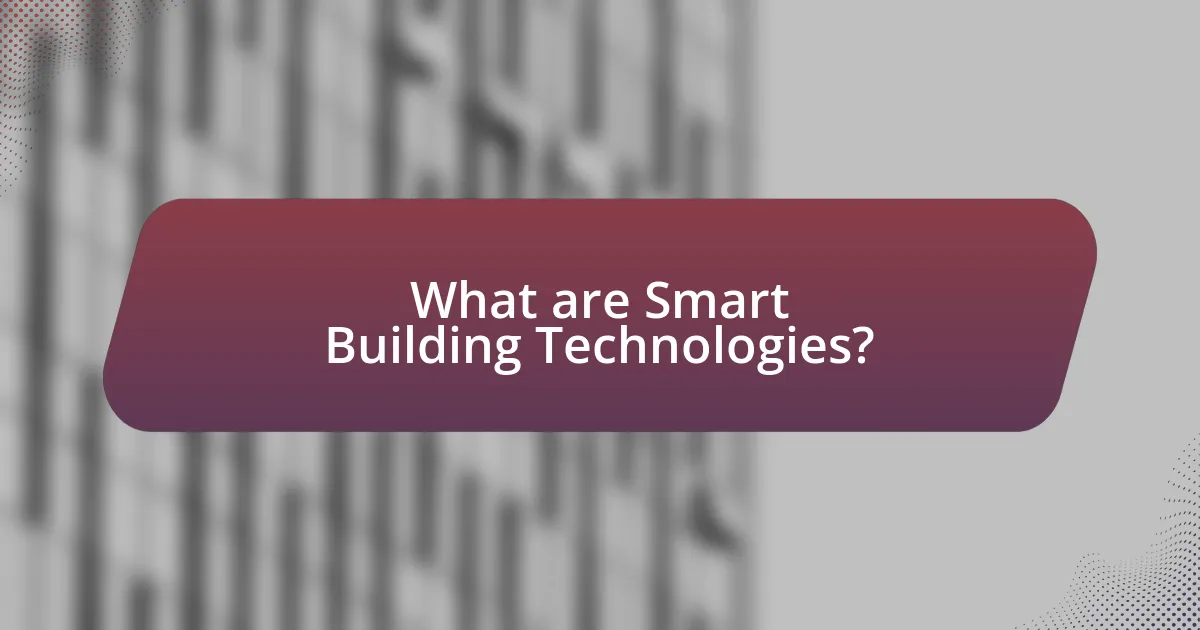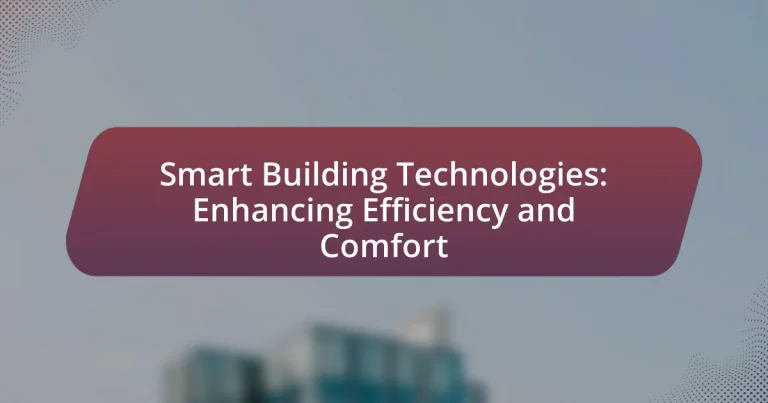Smart Building Technologies refer to advanced systems and solutions designed to enhance the operational efficiency, comfort, and sustainability of buildings. These technologies encompass automation systems, sensors, and data analytics that optimize energy use, improve occupant experience, and facilitate maintenance. Key components include building automation systems, energy management systems, advanced HVAC systems, smart lighting, and integrated security systems, all of which work together to reduce energy consumption by up to 30% and enhance overall building performance. The article explores how these technologies function, their primary goals, the challenges they address, and their impact on energy efficiency, occupant comfort, safety, and property value, while also discussing future trends and best practices for implementation.

What are Smart Building Technologies?
Smart building technologies are advanced systems and solutions that enhance the operational efficiency, comfort, and sustainability of buildings. These technologies include automation systems, sensors, and data analytics that optimize energy use, improve occupant experience, and facilitate maintenance. For example, according to a report by the International Energy Agency, smart buildings can reduce energy consumption by up to 30% through real-time monitoring and control of HVAC, lighting, and security systems.
How do Smart Building Technologies function?
Smart Building Technologies function by integrating various systems and devices to optimize building operations and enhance user experience. These technologies utilize sensors, IoT devices, and data analytics to monitor and control aspects such as lighting, heating, ventilation, air conditioning, and security. For instance, smart thermostats adjust temperature settings based on occupancy patterns, leading to energy savings and improved comfort. Additionally, building management systems aggregate data from multiple sources, enabling real-time decision-making and predictive maintenance. According to a report by the International Energy Agency, smart buildings can reduce energy consumption by up to 30% through such automated systems.
What are the key components of Smart Building Technologies?
The key components of Smart Building Technologies include building automation systems, energy management systems, advanced HVAC systems, smart lighting, and integrated security systems. Building automation systems enable centralized control of various building functions, enhancing operational efficiency. Energy management systems monitor and optimize energy consumption, contributing to sustainability. Advanced HVAC systems improve indoor air quality and comfort through precise climate control. Smart lighting utilizes sensors and automation to reduce energy usage while maintaining adequate illumination. Integrated security systems enhance safety through surveillance and access control technologies. These components collectively contribute to improved efficiency and comfort in smart buildings.
How do these components interact to enhance building performance?
Smart building technologies enhance building performance through the integration of various components such as sensors, automation systems, and data analytics. These components work together to optimize energy usage, improve occupant comfort, and streamline maintenance processes. For instance, sensors collect real-time data on temperature, humidity, and occupancy, which automation systems use to adjust heating, ventilation, and air conditioning (HVAC) settings accordingly. This interaction not only reduces energy consumption by up to 30% but also maintains a comfortable environment for occupants. Additionally, data analytics processes this information to identify patterns and predict maintenance needs, further enhancing operational efficiency and reducing downtime.
What are the primary goals of Smart Building Technologies?
The primary goals of Smart Building Technologies are to enhance energy efficiency, improve occupant comfort, and optimize operational performance. These technologies achieve energy efficiency by utilizing advanced systems for monitoring and controlling energy consumption, which can lead to reductions in utility costs and carbon emissions. For occupant comfort, smart buildings integrate environmental controls such as lighting, heating, and cooling systems that adapt to individual preferences and occupancy patterns. Additionally, operational performance is optimized through data analytics and automation, enabling proactive maintenance and resource management. According to a report by the International Energy Agency, smart buildings can reduce energy use by up to 30%, demonstrating the effectiveness of these technologies in achieving their primary goals.
How do Smart Building Technologies improve energy efficiency?
Smart Building Technologies improve energy efficiency by utilizing advanced sensors, automation, and data analytics to optimize energy consumption. These technologies enable real-time monitoring and control of building systems such as heating, ventilation, air conditioning, and lighting, leading to significant reductions in energy waste. For instance, a study by the U.S. Department of Energy found that smart building technologies can reduce energy use by 10-30% through improved operational efficiency and demand response strategies.
In what ways do they enhance occupant comfort?
Smart building technologies enhance occupant comfort primarily through improved environmental control, personalized settings, and enhanced air quality. These technologies utilize sensors and automation to maintain optimal temperature, lighting, and humidity levels, ensuring a comfortable indoor environment. For instance, studies show that smart thermostats can reduce energy consumption while maintaining preferred temperature settings, leading to increased occupant satisfaction. Additionally, smart lighting systems can adjust brightness and color temperature based on the time of day or individual preferences, further contributing to comfort. Enhanced air quality is achieved through smart ventilation systems that monitor and regulate indoor pollutants, ensuring a healthier living space.
What challenges do Smart Building Technologies address?
Smart Building Technologies address challenges related to energy efficiency, occupant comfort, and operational costs. These technologies optimize energy consumption through automated systems that adjust lighting, heating, and cooling based on real-time occupancy and environmental conditions. For instance, a study by the U.S. Department of Energy found that smart building systems can reduce energy use by up to 30%, significantly lowering operational costs. Additionally, these technologies enhance occupant comfort by providing personalized environments, which can lead to increased productivity and satisfaction.
How do these technologies contribute to sustainability?
Smart building technologies contribute to sustainability by optimizing energy use, reducing waste, and enhancing resource efficiency. These technologies, such as advanced HVAC systems, smart lighting, and energy management software, enable real-time monitoring and control of energy consumption, leading to significant reductions in greenhouse gas emissions. For instance, a study by the U.S. Department of Energy found that smart building technologies can reduce energy consumption by up to 30%, which directly correlates with lower carbon footprints. Additionally, these systems facilitate the integration of renewable energy sources, further promoting sustainable practices within urban environments.
What role do they play in reducing operational costs?
Smart building technologies play a crucial role in reducing operational costs by optimizing energy consumption and enhancing resource management. These technologies, such as automated lighting systems, smart HVAC controls, and energy monitoring tools, enable real-time adjustments based on occupancy and environmental conditions. For instance, a study by the U.S. Department of Energy found that smart building technologies can reduce energy costs by up to 30%, demonstrating their effectiveness in minimizing waste and improving efficiency. Additionally, predictive maintenance enabled by these technologies can lower maintenance costs by identifying issues before they escalate, further contributing to overall operational savings.
How are Smart Building Technologies implemented?
Smart Building Technologies are implemented through the integration of advanced systems and devices that enhance building operations and occupant comfort. This process typically involves the installation of sensors, automation systems, and data analytics platforms that monitor and control various building functions such as lighting, heating, ventilation, and security. For instance, according to a report by the International Energy Agency, smart building technologies can reduce energy consumption by up to 30% through optimized resource management. Additionally, these technologies often utilize Internet of Things (IoT) devices to facilitate real-time data collection and analysis, enabling proactive maintenance and improved operational efficiency.
What are the different types of Smart Building Technologies?
Smart building technologies encompass various systems designed to enhance operational efficiency and occupant comfort. Key types include building automation systems (BAS), which integrate HVAC, lighting, and security systems for centralized control; energy management systems (EMS), which monitor and optimize energy consumption; and smart lighting solutions, which adjust based on occupancy and natural light levels. Additionally, Internet of Things (IoT) devices facilitate real-time data collection and analysis, improving decision-making processes. These technologies collectively contribute to reduced energy costs and improved indoor environments, as evidenced by studies showing that smart buildings can achieve energy savings of 20-30%.
What is the role of IoT in Smart Building Technologies?
The role of IoT in Smart Building Technologies is to enable real-time data collection and analysis, which enhances operational efficiency and occupant comfort. IoT devices, such as sensors and smart meters, facilitate the monitoring of various building systems, including lighting, HVAC, and security. This connectivity allows for automated adjustments based on occupancy patterns and environmental conditions, leading to energy savings and improved indoor air quality. According to a report by McKinsey & Company, implementing IoT in buildings can reduce energy consumption by up to 30%, demonstrating its significant impact on sustainability and cost-effectiveness in smart building management.
How do automation systems integrate with Smart Building Technologies?
Automation systems integrate with Smart Building Technologies by utilizing centralized control platforms that manage various building functions such as lighting, HVAC, security, and energy management. These systems employ protocols like BACnet, Zigbee, and Z-Wave to facilitate communication between devices, enabling real-time data exchange and automated responses to environmental changes. For instance, a study by the National Institute of Standards and Technology (NIST) highlights that integrating automation systems can lead to energy savings of up to 30% by optimizing resource usage based on occupancy and usage patterns. This integration enhances operational efficiency and occupant comfort by ensuring that building systems respond dynamically to user needs and environmental conditions.
What are the benefits of adopting Smart Building Technologies?
Adopting Smart Building Technologies significantly enhances operational efficiency, reduces energy consumption, and improves occupant comfort. These technologies utilize sensors, automation, and data analytics to optimize building performance. For instance, a study by the U.S. Department of Energy found that smart building systems can reduce energy use by up to 30%, leading to substantial cost savings. Additionally, smart technologies enable real-time monitoring and control of HVAC, lighting, and security systems, which not only enhances comfort but also increases safety and productivity for occupants.
How do Smart Building Technologies enhance safety and security?
Smart Building Technologies enhance safety and security by integrating advanced systems such as surveillance cameras, access control, and environmental sensors. These technologies provide real-time monitoring and data analysis, allowing for immediate responses to potential threats. For instance, smart surveillance systems can utilize artificial intelligence to detect unusual activities, while access control systems can restrict entry to authorized personnel only, reducing the risk of unauthorized access. Additionally, environmental sensors can detect smoke, gas leaks, or intrusions, triggering alerts and enabling swift action. The implementation of these technologies has been shown to reduce security incidents by up to 30%, demonstrating their effectiveness in enhancing safety and security within smart buildings.
What impact do they have on property value?
Smart building technologies significantly enhance property value by improving energy efficiency, reducing operational costs, and increasing tenant satisfaction. Properties equipped with smart technologies, such as automated lighting, HVAC systems, and energy management systems, can see a value increase of up to 20% according to a study by the National Association of Realtors. Additionally, these technologies often lead to lower utility bills and maintenance costs, making the property more attractive to potential buyers or renters. Enhanced comfort and convenience features also contribute to higher demand, further driving up property values.
What are the future trends in Smart Building Technologies?
Future trends in Smart Building Technologies include increased integration of artificial intelligence, enhanced energy efficiency through IoT devices, and the adoption of advanced building materials. Artificial intelligence will enable predictive maintenance and optimize energy consumption by analyzing real-time data from various building systems. The Internet of Things (IoT) will facilitate seamless communication between devices, allowing for automated adjustments that improve energy efficiency and occupant comfort. Additionally, the use of advanced building materials, such as smart glass and energy-efficient insulation, will contribute to sustainability and reduced operational costs. These trends are supported by the growing demand for sustainable building practices and the need for improved occupant experiences in urban environments.
How is artificial intelligence shaping Smart Building Technologies?
Artificial intelligence is significantly shaping Smart Building Technologies by enabling enhanced automation, predictive maintenance, and energy efficiency. AI algorithms analyze data from various building systems, such as HVAC, lighting, and security, to optimize performance and reduce operational costs. For instance, a study by the International Energy Agency found that AI-driven energy management systems can reduce energy consumption in buildings by up to 30%. Additionally, AI facilitates real-time monitoring and predictive analytics, allowing for timely maintenance interventions that prevent costly breakdowns and extend the lifespan of building systems. This integration of AI not only improves operational efficiency but also enhances occupant comfort through personalized environmental controls.
What advancements can we expect in energy management systems?
Advancements in energy management systems will include enhanced integration of artificial intelligence and machine learning for predictive analytics, enabling more efficient energy consumption. These technologies will allow systems to analyze historical data and real-time usage patterns, optimizing energy distribution and reducing waste. For instance, a study by the International Energy Agency indicates that AI can improve energy efficiency in buildings by up to 30% through better demand forecasting and automated control systems. Additionally, the adoption of Internet of Things (IoT) devices will facilitate real-time monitoring and control, allowing for dynamic adjustments based on occupancy and usage trends, further enhancing energy efficiency in smart buildings.
What best practices should be followed when implementing Smart Building Technologies?
When implementing Smart Building Technologies, it is essential to prioritize interoperability among systems to ensure seamless communication and integration. This practice allows various technologies, such as HVAC, lighting, and security systems, to work together efficiently, enhancing overall building performance. According to a report by the International Energy Agency, buildings that utilize integrated smart technologies can achieve energy savings of up to 30%. Additionally, conducting a thorough needs assessment before implementation helps identify specific goals and requirements, ensuring that the chosen technologies align with the building’s operational objectives. Regular training for staff on the use of these technologies is also crucial, as it maximizes their effectiveness and promotes user engagement.





